Hurricanes are terrifying natural events, capable of causing widespread destruction and devastation. But what happens to the birds during these violent storms? It's a question many have, and understanding their behavior offers a fascinating glimpse into the resilience and adaptability of the avian world. This article delves into the strategies birds employ to survive hurricanes, exploring their remarkable abilities and the challenges they face.
How Do Birds Survive Hurricanes?
Birds possess a range of survival mechanisms to cope with the harsh conditions of a hurricane. Many species have an innate ability to sense changes in atmospheric pressure, wind speed, and barometric pressure, providing them with early warning signs of an approaching storm. This allows them to take proactive measures, often involving migration or seeking shelter.
Some birds will fly ahead of the storm, attempting to outrun the hurricane’s path. This requires significant energy expenditure and depends on the bird's strength and flight capabilities. Smaller birds may struggle with this strategy, while larger, stronger birds like albatrosses have a better chance of successfully fleeing the approaching storm.
Those unable to migrate often seek shelter. This might involve finding dense foliage, caves, or even human-made structures for protection. The denser the cover, the better the protection from high winds and debris. Birds are also adept at finding crevices and other natural shelters that provide refuge from the storm’s fury.
What Happens to Birds During a Hurricane?
During the storm itself, birds face numerous dangers. High winds can dislodge them from their roosts, causing injuries or even death. Heavy rainfall and flooding can submerge nests and foraging grounds, leading to food scarcity and loss of habitat. Flying debris, such as tree branches and building materials, presents another significant threat, capable of inflicting severe injuries.
Additionally, the dramatic pressure changes associated with hurricanes can disorient some birds, affecting their navigation and ability to fly effectively. This is particularly challenging for birds that rely on visual cues or magnetic fields for orientation.
Where Do Birds Go During a Hurricane?
The location a bird chooses for shelter during a hurricane depends largely on the species and its individual capabilities. Some will seek out dense forests or mangrove swamps, while others might find refuge in caves or rock crevices. Coastal birds might venture further inland, seeking higher ground to escape storm surges and flooding. Urban birds may seek shelter in buildings, under eaves, or in dense shrubbery. Ultimately, the goal is to minimize exposure to high winds, rain, and flying debris.
Do Birds Die in Hurricanes?
While many birds survive hurricanes, unfortunately, some do perish. Mortality rates vary depending on the intensity of the storm, the species of bird, and the availability of suitable shelter. Those with weaker flight capabilities, those with nests at low elevation, or those caught in the open during the peak of the storm are most vulnerable. The aftermath of the storm can also lead to increased mortality due to starvation, injury, and loss of habitat.
How Do Birds Know a Hurricane is Coming?
The precise mechanisms by which birds detect impending hurricanes are still being researched. However, it’s believed that a combination of factors plays a role. Changes in barometric pressure, wind direction and speed, and even infrasound (sounds below the range of human hearing) may all provide cues. Some scientists hypothesize that birds may also perceive subtle changes in electromagnetic fields or in the polarization of light.
Can Birds Predict Hurricanes?
While birds don't predict hurricanes in the same way humans do, their behavioral changes in response to subtle atmospheric shifts can serve as indicators of an approaching storm. Their heightened activity, seeking shelter, and mass migration can be observed before the storm hits, providing valuable, albeit indirect, insights into the approaching danger. However, it's important not to rely solely on bird behavior for hurricane predictions; official weather warnings remain the most reliable source of information.
In conclusion, the resilience of birds during hurricanes is a testament to their remarkable adaptability. While they face significant challenges, their diverse survival strategies allow many to weather the storm and continue to thrive. Continued research into bird behavior during these events continues to deepen our understanding of these fascinating creatures and the intricate relationship between wildlife and the environment.
